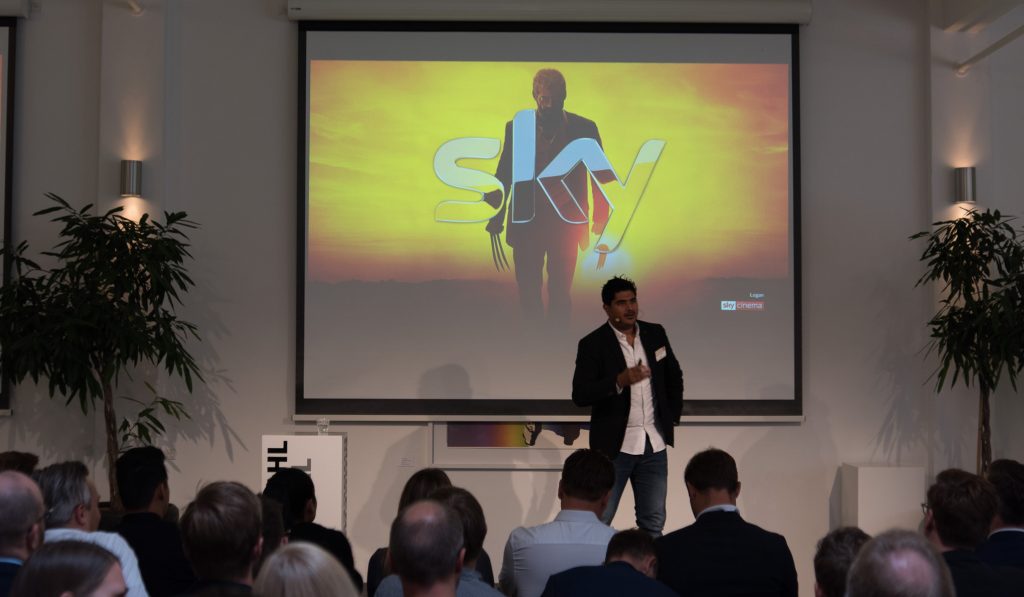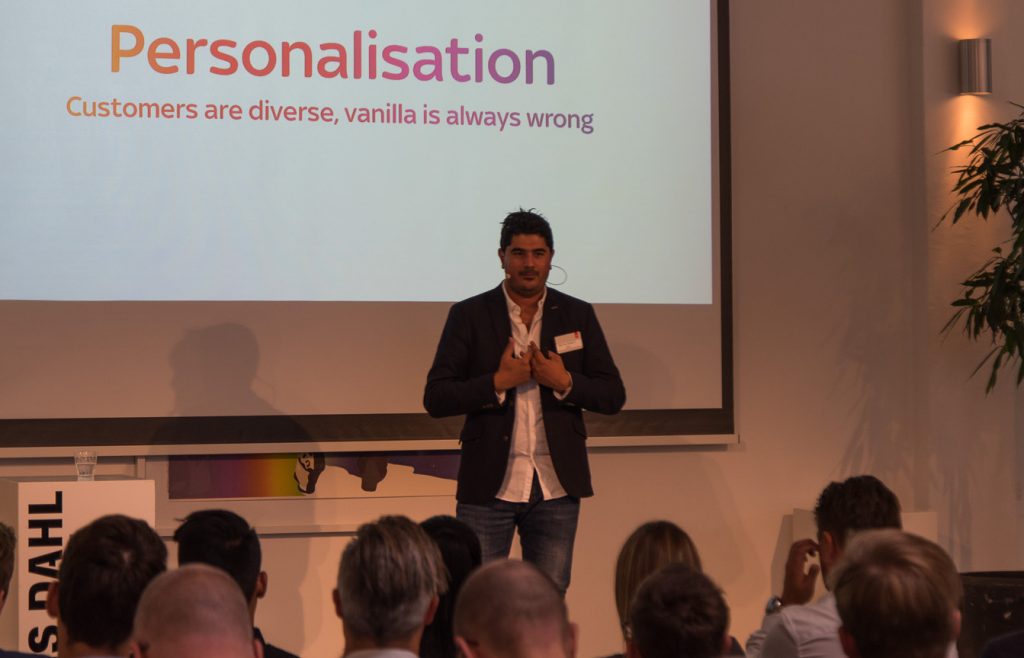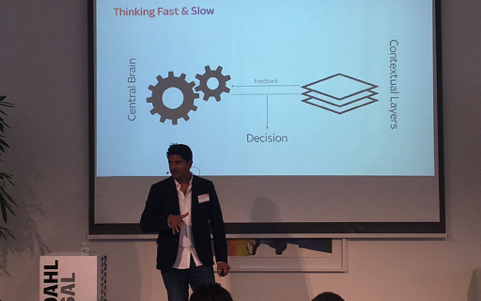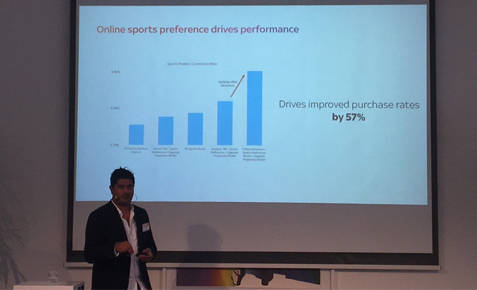in Danish
Tuesday this week, Skys Head of Digital Analytics and Decision, Rob McLaughlin, gave the opening keynote address at Adobe’ and eCapacity’s Experience Breakfast in Copenhagen. Sky is UKs second largest telco, the largest (11 million customers) pay-TV broadcaster and – with an advertisement spending of over £ 400 million a year – also UK’s largest advertiser.

Rob McLauglin, Head of Digital Analytics and Decision, Sky, on stage in eCapacity and the Adobe event on August 28, 2018
Over the last few years, Sky has, assisted by among others eCapacity and Adobe, established an extensive data and personalization setup, and it was Sky’s experience with this, Rob McLaughlin’s keynote centered on. We have selected the six main points with particular relevance for all about to increase their personalization activities, based on AI, machinelearning and data.
1. “IT’S AN ABSOLUTE FUNDAMENTAL”: YOU MUST BE ABLE TO RECOGNIZE YOUR CUSTOMERS NO MATTER WHAT DEVICE THEY ARE USING
Beforehand Sky only knew who you were, if you logged in when you visited them online. And only about 30% did. The huge remaining amount of visits, Sky could not identify. One particular problem posed to Sky was device usage: Skys systems could not recognize the same user when, after having used eg. their mobile on their first visit, on they on their nex visit used their tablet or desktop computer. And this Sky users often do: According to Sky’s latest stats, the average user uses between 6 and 8 different devices.
Today Sky binds the various devices together, so a full 70% of their visits now are identified and recognized and assigned each their own unique, unified ID. In this way Sky can identify 7 out of 10 visits and tie them to an specific person or household – no matter whether the customer is currently browsing from mobile, tablet or computer. Or if he or she is logged in or not.
Without this stitching of devices, personalization would be meaningless, Rob McLaughlin pointed out: “It’s an absolute fundamental.” How else do you personalize, if it’s pure guesswork, who you personalize for?
2. “ONE SIZE FITS NOBODY”: ALWAYS TRY TO PERSONALIZE THE EXPERIENCE.
Although true personalization can be difficult, don’t stop trying. Going for the lowest common denominator, rarely gets you good results.

If you go for the lowest common denominator, you’ll fail. “Vanilla is allways wrong”.
Personalizing doesn’t it have to be difficult either. From an organizational point of view, Sky has a dedicated Adobe specialist team for their personalization systems, but in day to day operations they’re perfectly able to fine-tune and handle the completed AI modules in their Adobe setup, relying on their usual analyst skills. And set up regular rule-based segmentation, too.
3. “IT’S LIKE TREES IN THE FOREST”: IT DOESN’T MATTER THAT YOU ARE WRONG
In all personalization, the built-in risks are, that you simply get the individual in front of you wrong. This should not hold you back, however. Keep in mind that only one of your many users is experiencing your mistake. No one else sees it. “It’s like trees in the forrest,” says Rob McLaughlin. You only see the forrest – not the individual trees. It takes a lot of many small errors for before the larger picture blurs.
4. “GET THE F… OFF MY DATA – BE MORE LIKE NETFLIX (!)”: PERSONALIZE FOR PROBABILITY
No matter how many efforts you go through when you personalize, there’ll almost certainly be someone, you’re not able to target correctly. Therefore, don’t be to direct, when choosing how to word your personalization messages. Don’t say: “We know you are x, y or z – therefore you need product a, b or c”. Phrase it softer and think of the user you personalize for, as a probability more than an individual. Nudge more, command less.
In this way, you’ll be able to avoid the creepiness trap too. That users feel overtly surveilled and fear their data will be abused. While at the same time making sure, the users are given the relevant and relevant experience they also want. You’ll be able to balance between customers’ ”get the f… off my data. You do not have the right to use it”, as Rob McLaughlin puts it – and the same customer requirements: “Why can’t you be more like NetFlix (!) ”
5. SET “GENERAL BUSINESS RULES” AT THE CENTER. WITH CONTEXTUAL AI ALGORITHMS ABOUT
Not all personalization at Sky is based on AI and machine learning. In fact, old-fashioned rule-based personalization still performs slightly better than the algorithm-based when measured on sales uplift. Rulebased personalization is also still at the center of Sky’s personalization.

Rule- and human-based personalization is central to Skys personalization. On top of this, AI- and machinelearning based algorithms resides. Rob McLauglin, Head of Digital Analytics and Decision, Sky.
The rule-based personalization is based on customer attributes deemed important from a pure – and human-based – business point of view. Are you a customer or not?, which products have you purchased?, which campaigns are you covered by? Etc.
On top of this, AI- and machinelearning-based algorithms supplements and refines teh personalization. They involve the contextual layer surrounding the specific customer interaction. Here the algorithms are fueled by information ranging from stas about at what time of the day which messages works the best an which sites their referred from to data about what sports news the read on Skys news services and what broadcasts they watch on their set-top boxes.

In a specific case, machine learning and AI based on customer sports news readings increased sales by 57%. Rob McLauglin, Head of Digital Analytics and Decision, Sky
6. PERSONALIZE ON ALL CHANNELS
Also: think Omnichannel. At Sky, personalization is not just about what happens at their website. It’s also about email, call-center and TV-sets.
For example, Sky found that customers with a set top box, which they hardly ever use, are in danger of churning. Especially, the Sky data shows, if the customer also has children but doesn’t use Skys Kids app. Or if they’re VIP customers who have never unlocked their benefits.
On this basis Sky builds personalized messages addressing the looming churn. And they do it on all relevant channels. If the customer visits Sky online, he is greeted by special messages intended to persuade him to stay. Other variations are displayed on the set-top box and in emails. Some customers will even receive a call from the call center. And it works.
HOW CAN ECAPACITY HELP?
Skys six personalization takeways can be used as they are. But if you are about to undertake efforts to increase your personalization efforts towards customers, and need assistance in the process, we’re here to help you out. We have specialized in establishing platforms for personalization, blueprinting the organizational implementation and ensuring that the business value is realized.
We can assist your business in designing the personalization vision – from defining and prioritizing efforts in relation to your company’s established strategic goal to designing the personalization architecture to executing the end-to-end personalized customer experience that realizes the value.
Skys personalization setup is based on an almost pure Adobe suite, where Adobe Analytics collects data, Adobe Audience Manager (Adobe’s so-called DMP) connects Skys different channels, Adobe Target performs the actual AI-based personalization which is then executed on their websites and through Adobe Campaign, controlling Sky’s outbound channels, such as emails and text messages. If you’re considering a similar setup, our team of Adobe specialists can help.
We at eCapacity are experts in commercial use of digital channels. And we have over ten years of experience with commercial and strategic digital issues that can make your business a success. Call tel. +45 70 26 27 23, write to info@ecapacity.dk or directly to Martin Wammen or Andreas Petersson for a non-binding chat.
in Danish
